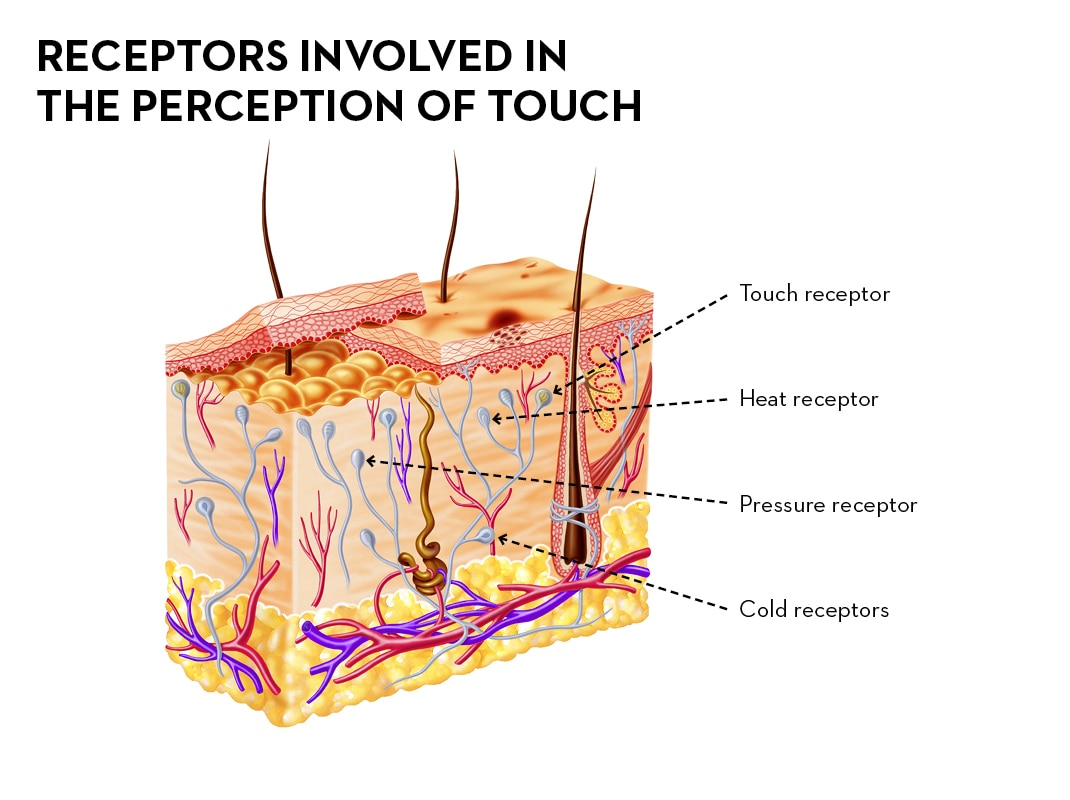Ever wondered why you feel better after a nice long hug?
Or maybe you’ve noticed that new parents soothe babies by swaddling them up tight.
This soothing sensation has a name – deep pressure stimulation – and it plays a huge role in soothing our nervous system.
Deep pressure stimulation is even responsible for the reason that using a weighted blanket can help many people fall asleep faster and stay asleep longer.
So how and why is deep, pressurized touch so soothing?
What is Deep Pressure Stimulation?
The science behind the mechanics of deep pressure stimulation ties back to the way our bodies sense and interpret the sensation of touch.
Our sensory systems help us detect stimuli like sight, sound, taste, smell, and touch. Nerve endings called receptors send signals to the brain about the sensory information we experience.
For example, photoreceptors within our eyes become stimulated by different light wavelengths. These send signals to our brain, interpreting the colors and shapes we see.
Taste receptors across the tongue lead to the sensations of different tastes based on the chemical makeup of the food we eat, sending signals to the brain that identify bitter, sour, sweet, or salty flavors.
Moreover, thermoreceptors help us to sense heat and cold temperatures. These receptors are responsible for the sensation of “goosebumps” when we feel cold.
Evolutionarily, goosebumps form to pull hair upright and increase body temperature by trapping heat closer to the skin. This is especially evident for animals with thick fur.
Our skin is also armed with tons of sensory receptors that help us to detect and identify different touch stimuli.
Special nerve endings in the skin allow us to discern light touch from deep pressure.
Deep pressure stimulation activates our touch sensory system by providing steady, heavy pressure known to improve emotional processing and feelings of connection.
Steady, firm pressure activates our parasympathetic nervous system, taking us from an anxious state of fight or flight into rest mode.
As a result, we shift into a state of calm and contentment.
The parasympathetic activation caused by deep pressure stimulation explains why hugs are such a huge part of human connection and emotional well-being.
In fact, family therapist Virginia Satir is quoted as saying, “ “We need four hugs a day for survival. We need eight hugs a day for maintenance. We need 12 hugs a day for growth”.
Using a weighted blanket provides deep touch stimulation (similar to a hug) anytime, anywhere – and it’s the perfect antidote for insomnia.
The Perks of Using a Weighted Blanket
Deep pressure stimulation achieved through using a weighted blanket is commonly praised as a solid solution for improving sleep.
Firm, gentle pressure helps to prepare the body for rest by lowering our heart and breathing rates while activating our parasympathetic nervous system.
When we’re stressed or anxious, the body releases the stress hormone cortisol. Over time, this leads to sleep challenges.
Using a weighted blanket is proven to boost levels of the feel-good chemicals dopamine and oxytocin while lowering cortisol, thus decreasing anxiety and enhancing sleep.
Using a weighted blanket is also thought to increase melatonin and serotonin production, setting the scene to make you feel groggy and ready for rest.
In fact, a 2022 study found that using a weighted blanket leads to a significantly larger release of melatonin at bedtime.
@somnifix Is a #weightedblanket a solid solution for better #sleepquality 🤔 or just a fad? Science says they’re effective based on the #deeppressurestimulation they provide, taking #melatonin and serotonin levels up while bringing #stress hormone levels down. 🏋️ #deeppressuretherapy ♬ Blue Spirits - DWLLRS
If you suffer from restless leg syndrome that disrupts your sleep, a weighted blanket may help relieve the agitating symptoms of your condition by providing deep, steady pressure to your legs.
What’s more, if you suffer from a mental health condition like post-traumatic stress disorder (PTSD), using a weighted blanket may help aid in symptoms, according to the PTSD Journal.
Whether you want relief from insomnia, restless leg syndrome, or you want to improve your mental well-being, a weighted blanket offers a quick, simple solution that you can take anywhere.
However, there are certain precautions to keep in mind when choosing a weighted blanket that will work for you.
Selecting a Weighted Blanket
While using a weighted blanket is a perfect way to achieve deep pressure stimulation for better sleep, some people may need to take extra precautions prior to using one.
For example, if you have a medical condition like asthma, low blood pressure, diabetes, claustrophobia, or obstructive sleep apnea, speak to your doctor before using a weighted blanket.
Your blanket selections may differ depending on your personal preferences.
Typically, weighted blankets range from 5 lbs up to around 35 lbs and come in different sizes like twin, full, queen, and king.

When selecting your weighted blanket, a good rule of thumb is to opt for one with a weight equivalent of about 10 percent of your body weight.
For example, if you weigh 130 lbs, purchase a 13 lb blanket.
The material you choose matters, too. For example, a cotton weighted blanket offers more breathability than other fabrics.
Most weighted blankets use either plastic poly pellets or glass beads that are around the size of a grain of sand.
Glass beads are typically heavier and smaller than plastic pellets, meaning that your blanket will be a bit thinner if it contains glass beads.
Moreover, some weighted blankets include a fiberfill for added warmth. Select a blanket without fiberfill for a cooler option.
For easy cleaning, choose a weighted blanket with a removable, washable cover.
Once you’ve chosen your weighted blanket, hit the sheets and try it out. Just be sure you’re breathing optimally at night for the biggest sleep boost.
Stimulate Better Breathing With SomniFix
Deep pressure stimulation shifts the body from a state of fight or flight to a state of rest and relaxation.
Breathing through the nose instead of the mouth causes the same parasympathetic activation known to decrease stress and boost sleep quality.
Breath is the elixir of life – and the way you choose to breathe directly influences your quality of life. The nose warms, filters, and humidifies the air we breathe. The mouth doesn’t.
Moreover, mouth breathing causes poor oxygenation, increased stress, and may even lead to snoring during sleep.
When we mouth breathe during sleep, airway tissues fall backward and vibrate together, causing snoring.
That means disrupted, fragmented sleep. Nasal breathing, however, prevents snoring while enhancing sleep quality and duration.
So how do you make sure you’ll nasal breathe all night long? Mouth tape.

Much like using a weighted blanket for deep pressure stimulation and better sleep, mouth tape ensures a proper lip seal to promote nasal breathing, prevent snoring, and boost oxygenation.
Before you slap on any tape, watch out for the chemicals within most tape adhesives. They’re known to cause rashes, irritation, and discomfort.
SomniFix was crafted with even the most sensitive skin in mind. Our strips are created with hypoallergenic materials free of latex and gluten.
Our gel-like adhesive is so comfortable you’ll forget you’re even wearing mouth tape to bed. Our strips also include a patented breathing vent that offers an emergency mouth breathing option if you become congested overnight.
Much like a weighted blanket is the perfect solution for deep pressure stimulation, SomniFix is the perfect solution for snoring prevention and enhanced sleep quality.
Stimulate better overnight breathing with SomniFix tonight!





